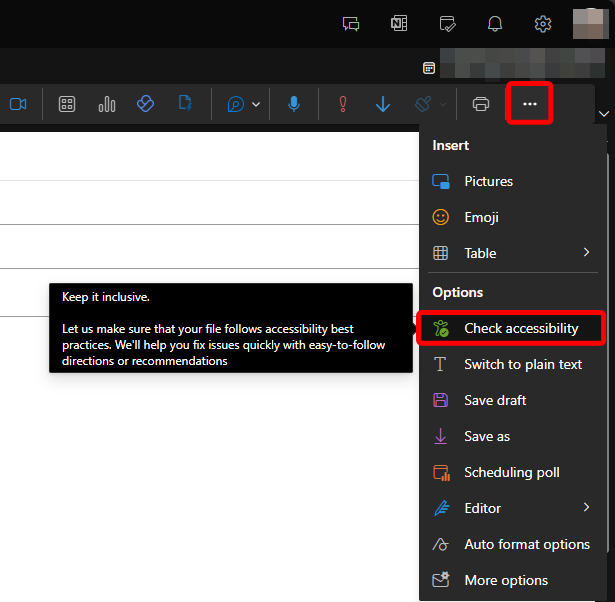Additional Accessibility Guides
Outlook Accessibility
 Crafting accessible emails helps ensure communication is readable by all recipients. The instructions below are specific to Outlook, but the principles apply to all email clients.
Crafting accessible emails helps ensure communication is readable by all recipients. The instructions below are specific to Outlook, but the principles apply to all email clients.
On this page
Subject
Include a descriptive, unique subject line to guide assistive technology and help recipients understand purpose.
Accessible Fonts and Style
- Use automatic colour combinations (black text on white background, white text on black background).
- Ensure any other colours used have a contrast of at least 4.5:1 against the background.
- Do not rely on colour alone to convey information.
- Use readable fonts that are sans-serif or basic serif and at least 12 point size.
- Avoid excessive use of italics, bold, or all caps.
- Reserve underline for hyperlink text.
Review font accessibility best practices.
Links
Use meaningful hyperlink text in place of bare URLs.
For Outlook on the web:
- Type descriptive, unique text for the link destination.
- Select the text.
- Select the Insert Link button on the formatting toolbar or press CTRL + K/CMD + K on macOS.
- Selected text is in the Display as field.
- Paste the URL in the address dialog.
For Outlook on desktop:
- Type descriptive, unique text for the link destination.
- Select the text.
- Right click and select Link or press CTRL + K/CMD + K on macOS.
- The text you selected is displayed in the Text to display field.
- Paste the URL in the address dialog.
Consult accessible links chapter for more information.
Alternative Text
Add alt text to images so that recipients who cannot view the image can determine its purpose and context.
For Outlook on the web:
- Right click on an image and select Add Alternate Text.
- Type your description and click OK.
For Outlook on desktop:>
- Right click on an image and select Edit Alt Text.
- Type your description in the dialog.
Plain Language
Use clear, concise language.
- Avoid assuming recipients’ knowledge.
- Explain abbreviations, initialisms, and acronyms.
- Make clear requests.
- Provide summaries of long emails.
Learn more about plain language.
Structure
While HTML emails support headings (and should be included in long emails that have distinct sections), when adding headings consider if email is the most appropriate document format for such dense material.
Use built-in tools for lists, tables, alignment, and indents.
Accessibility Checker
 Outlook on the web includes an accessibility checker. Select the three dot icon on the Send/Discard toolbar and choose Check accessibility.
Outlook on the web includes an accessibility checker. Select the three dot icon on the Send/Discard toolbar and choose Check accessibility.
The Check accessibility tool will note colour contrast issues, missing table headers, and images without alt text.
Learn more about Outlook accessibility settings here.
Further Resources
Consider the Microsoft guide to Outlook accessibility. The website should responsively display information based on your device, but you can also switch tabs (Windows, Web, MacOS, iOS, Android) to see specifics for your device(s).
When creating email lists, newsletters, or email campaigns, use the checker on accessible-email.org to ensure content is accessible.

